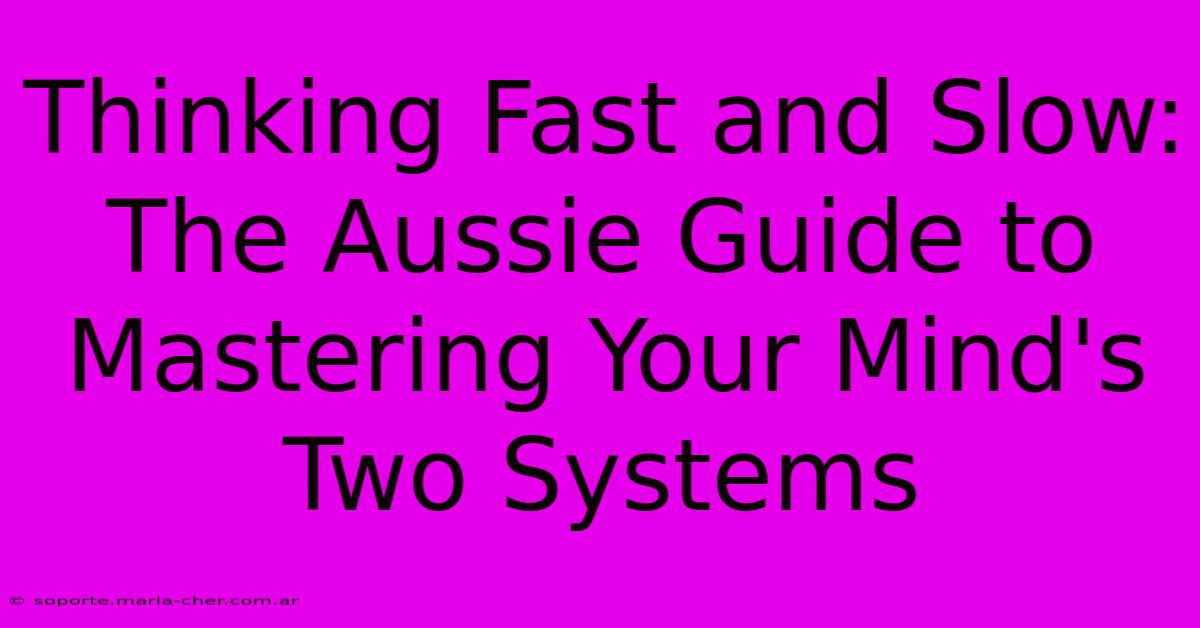Thinking Fast And Slow: The Aussie Guide To Mastering Your Mind's Two Systems

Table of Contents
Thinking Fast and Slow: The Aussie Guide to Mastering Your Mind's Two Systems
G'day, mates! Ever felt like your brain's got two personalities battling it out? Like one's a quick-thinking larrikin, while the other's a slow-and-steady, thoughtful professor? You're not alone. This Aussie guide dives into Daniel Kahneman's groundbreaking work, Thinking, Fast and Slow, explaining its core concepts in a way that's both easy to understand and relatable to the Aussie experience.
We'll unpack the two systems – System 1 (fast thinking) and System 2 (slow thinking) – and how understanding them can help you make better decisions, avoid cognitive biases, and generally navigate life a bit more smoothly. Think of it as your ultimate mental upgrade, straight from the outback to your brain!
System 1: The Aussie Larrikin – Fast, Intuitive, and Emotional
System 1 is your gut feeling, your instant reaction. It's that quick, intuitive voice that helps you catch a cricket ball, recognise a friend's face, or instantly know that something feels "off." It's the brain's automatic pilot, working tirelessly in the background, processing information effortlessly.
Think of it like this: you're driving down a familiar road, and your System 1 is handling the basics – steering, braking, accelerating – without much conscious effort. It’s efficient, but it can also be prone to shortcuts and biases.
The Strengths of System 1:
- Speed and Efficiency: It makes lightning-fast decisions, crucial for reacting quickly in everyday situations. Think dodging a rogue footy during a backyard barbie!
- Intuitive Understanding: It helps us understand social cues and navigate complex situations instinctively.
- Emotional Engagement: It adds the emotional colour to our experiences, making life more engaging and meaningful.
The Weaknesses of System 1:
- Cognitive Biases: System 1 is susceptible to various biases, such as confirmation bias (favouring information that confirms existing beliefs) or anchoring bias (over-relying on the first piece of information received). Imagine getting caught up in a pub argument based on a dodgy rumour!
- Overconfidence: It can lead to overconfidence in our judgments, making us less likely to question our assumptions.
- Limited Analytical Ability: It lacks the depth and precision of System 2.
System 2: The Professor – Slow, Deliberate, and Analytical
System 2 is the more thoughtful, deliberate side of your brain. It's the one that takes over when you need to concentrate, solve complex problems, or make important decisions. It's your internal professor, carefully weighing up the pros and cons, analysing information, and applying logic.
Imagine tackling a tricky tax return or planning a week-long camping trip in the Kimberley. That's System 2 in action. It demands effort and concentration, but it's much more reliable for complex tasks.
The Strengths of System 2:
- Analytical Power: It’s capable of rigorous analysis and critical thinking.
- Problem-Solving: It helps us solve complex problems and make well-reasoned decisions.
- Self-Control: It helps regulate our impulses and emotions, ensuring we make rational choices rather than impulsive ones.
The Weaknesses of System 2:
- Cognitive Laziness: It's energy-intensive and prefers to avoid demanding tasks whenever possible. The "she'll be right" mentality can sometimes kick in!
- Limited Capacity: It can only handle a limited amount of information at once. Trying to juggle too many things at once can lead to errors.
- Slowness: It's not as fast as System 1, which can be a drawback in time-sensitive situations.
Mastering Both Systems: The Aussie Approach
The key isn't to suppress one system in favour of the other. Instead, it's about understanding how both work and using them effectively. Think of it like a good Aussie BBQ – you need both the fast flames for searing and the low, slow heat for perfecting that barbie.
Here’s how to master your mental systems:
- Become Aware of Your Biases: Recognising your biases is the first step to mitigating their impact. Take a step back and question your initial gut feelings (System 1).
- Engage System 2 More Often: For critical decisions, force yourself to slow down and engage in more thoughtful analysis. Don't rush into anything.
- Find a Balance: Learn to utilise both systems effectively, harnessing System 1’s speed and intuition while using System 2 for deeper analysis when necessary. It's all about finding the right balance for each situation.
By understanding and mastering your mind's two systems, you’ll be better equipped to make smarter decisions, avoid costly errors, and navigate life's challenges with a bit more clarity and confidence. So, throw another shrimp on the barbie and get thinking!

Thank you for visiting our website wich cover about Thinking Fast And Slow: The Aussie Guide To Mastering Your Mind's Two Systems. We hope the information provided has been useful to you. Feel free to contact us if you have any questions or need further assistance. See you next time and dont miss to bookmark.
Featured Posts
-
Transform Passive Writing Into Active Gold Say Goodbye To Dull Words Hello To Engaging Lines
Feb 09, 2025
-
The Art Of Etiquette How To Write Thank You Emails That Shine
Feb 09, 2025
-
Surgical Savings Blueprint Maximizing Value In Acl Reconstruction Surgery Cost
Feb 09, 2025
-
Unlock The Seo Potential Of Your Ceo Email Signature A Comprehensive Guide To Serp Dominance
Feb 09, 2025
-
The Art Of Email Signature Mastery Crafting Quotes That Captivate
Feb 09, 2025
